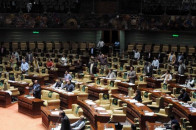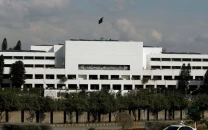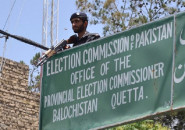Umar Saif: rebel with a cause
Poets are dreamers. So are mavericks

The writer works for the public sector. He moonlights as a journalist and is a graduate of the University of Warwick
Punjab has always seemed greener, happier to most, known for its fertile plains and a pervasive joie the vivre. Which is surprising given that it functions like any other province in Pakistan, ruled by the same decades-old governance system that has outlived its utility. Things got shaken up a bit five years ago when the province decided to embrace technology to improve service delivery. Derided and dismissed generously by naysayers, the Punjab Information Technology Board (PITB) took on the daunting challenge of fighting the crippling stasis through tech-inspired innovation. That the new kid on the block drew smirks was hardly surprising. Fast forward to 2017. The kid has grown up and turning the tables on the traditional framework of thinking and doing things. The candle of change set alight half a decade ago by Chief Minister Shahbaz Sharif, now threatens to become a firestorm, a harbinger of the IT revolution in Pakistan’s most populous province, Punjab. In the eye of this storm is an unassuming, young man, Dr Umar Saif.
Dr Umar Saif, an alumnus of MIT and Cambridge, is Punjab’s best kept secret. After completing a brilliant academic career at Cambridge, he turned away from a lucrative career abroad and returned to serve his home country in 2005. He became one of the youngest tenured professors at the Lahore University of Management Sciences and immediately set off on his quest to acquaint the unbounded IT talent in Pakistan with the fast-paced, ever-changing global IT landscape. Over the next few years he not only maintained a fulltime teaching position, but also headed multimillion dollar, cutting-edge research projects, founded Pakistan’s first tech incubator and introduced the startup culture in the country. In 2011, Dr Saif became the first Pakistani to be named the prestigious top 35 young innovators in the world by MIT Technology-Review (TR35). This generated significant media attention, catching the attention of the Chief Minister of Punjab, Muhammad Shahbaz Sharif. Blessed with a keen eye for talent, he invited Dr Saif to head the IT wing of the Punjab government; the Punjab Information Technology Board (PITB).
The rest as they say is history. It has been half a decade of innovation and positive disruption unleashed with Dr Saif at the helm of PITB. Driven to reinvent governance through technology, the PITB under Dr Saif conceived and executed IT interventions in multiple areas of governance including health, education and the police. From the computerisation of land records across Punjab to the automation of Hajj Operations to the Metro Bus Command & Control System, from digitising the stamp papers through the e-Stamping initiative to automation of court cases through the Case Flow Management System, from the revolutionary public education initiative e-learn. Punjab to the Centralised Motor Vehicle Registration System, from disease surveillance to IDPs registration, from the digitisation of the Criminal Record Office (CRO) to the development of an overarching criminal profiling system to fight crime, Dr Saif personally oversaw a buffet of IT innovations that aimed at significantly improving the citizen experience through automation, process re-engineering, improved transparency and accountability.
These groundbreaking interventions are successfully challenging the systemic inertia and raising the bar of public expectations. The progress in Punjab naturally attracted attention as the Chief Ministers of both Sindh and Gilgit-Baltistan and the Prime Minister of AJK visited of PITB to meet Dr Saif and discuss how best to emulate the Punjab model in their respective regions. Dr Saif has emerged to become the technocrat with the most powerful voice. Global publications including Time magazine, Foreign Policy magazine and The Washington Post have lavished praise on his work, while leading universities like Princeton have commissioned case studies on his projects. Top international organisations like the World Bank, DFID and GIZ constantly seek his collaboration and advice on how best to navigate the treacherous world of Pakistani politics and channel relief to the citizen. Dr Saif’s governance improvement programme; the Citizen Feedback Monitoring Program (CFMP) proved so effective that it was replicated by the European states of Albania and Romania.
The story does not end here. As if resurrection of the governance edifice is not enough, Dr Saif, with any eye on the burgeoning youth bulge of Pakistan, commissioned Plan 9, Pakistan’s largest government owned startup incubator. The idea was to foster the startup culture in Pakistan, to empower our youth by promoting both self-employment and independence of thought and action. Plan 9 has been a roaring success and many of its graduates have gone on to secure millions of dollars in funding from local and international investors.
Dr Saif is not given to exaggeration and self-praise but can’t resist narrating his favorite story, how he founded the little MIT of Pakistan. “It was the year 2002; Boston was shut down due to heavy snowfall and my lecture at MIT had been rescheduled. I decided to stay in my apartment and use the time to complete a proposal for my dream project; starting a research university in technology in Pakistan that would emulate the academic structure of MIT. I lovingly titled my dream, MIT for Pakistan”. He became the founding Vice Chancellor of Information Technology University (ITU) and the youngest VC of any university in Pakistan at that time. ITU is Punjab’s first dedicated IT university armed with a world class faculty and cutting edge facilities. In order to establish a credible scientific publication in Pakistan, ITU has licensed MIT’s Technology Review magazine, one of the most credible scientific publications in the world. The Pakistan version is printed every two months and covers a range of areas.
Dr Umar Saif has achieved a lot at a young age and has plans for a lot more. The golden boy, as he is sometimes lovingly referred to, was recently elevated and appointed as an Adviser to the Chief Minister Punjab in recognition of his outstanding services to the country. Meeting him can be unsettling given his impeccable academic credentials having attended the best of the best, Cambridge and MIT. Not to mention his repute for an intimidating work ethic and fierce delivery orientation. And then you actually meet him only to be bowled over by his eloquence, disarming humility and cracking wit. Punjab under CM Shahbaz Sharif is taking huge strides in employing technology to improve service delivery in multiple areas of public concern. The PITB under Dr Umar Saif remains the pivot of this paradigm shift centered on tailored tech interventions to disrupt and overturn the status quo.
Published in The Express Tribune, February 18th, 2017.
Like Opinion & Editorial on Facebook, follow @ETOpEd on Twitter to receive all updates on all our daily pieces.



















COMMENTS
Comments are moderated and generally will be posted if they are on-topic and not abusive.
For more information, please see our Comments FAQ